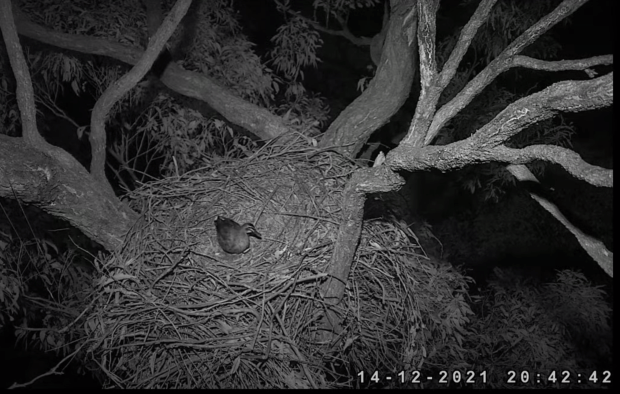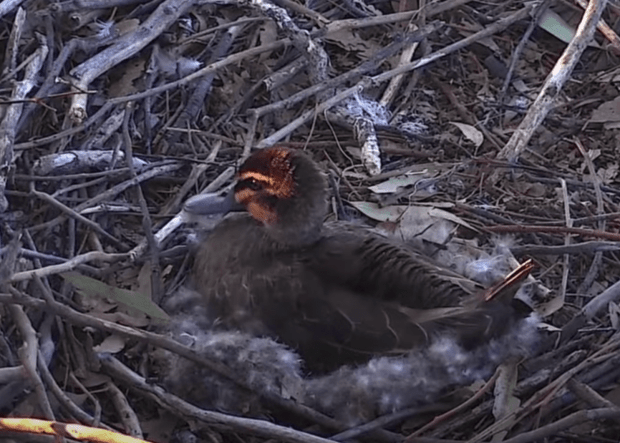The Sydney Olympic Forest is quiet. The wind is rocking Daisy and her eggs as she gets some sleep in the quiet of the afternoon. By the time she leaves her nest for her break to eat and go to the bathroom, she will have been on the nest for almost a solid 22 hours. Without a break. Not one. I think the possum frightened Daisy this morning right when she should have left for foraging. I hope that it doesn’t happen again.
By normal calculations this is day 6 of hard incubation. Duck eggs take from 26-30 days. This means Daisy has three more weeks to thwart all that would wish to eat those eggs or get her off their nest. Those bookmakers that take bets on almost anything probably have the odds flat against our little duck. I don’t want to get my hopes up – it is true that everything seems like it is against her but, just in case, I think I am going to dream up something nice to have on hand ‘just in case’. As I said in my earlier blog, seeing Daisy and her ducklings leap off that nest would really start 2022 off right.

I am very anxious for Daisy today. It is all because she did not go off the nest to forage before sunrise. It is now 16:21 and she has three and a half hours until sunset. I think that she would be safe to leave a wee bit before then. I notice that the birds in our garden have left the lilac bushes and feeders about an hour to an hour and a half before sunset each day. Maybe the Ravens do that as well?

Every time Daisy starts gathering leaves or moving about as she did about ten minutes ago, I think she is going to leave. The Ravens are smart. They haven’t come on the nest after Daisy fearlessly protected her eggs but they have been around several times to check to see if she is there. They know those eggs are in that nest and they would not hesitate if our little duck was away.
The light changes on the nest continually. Half an hour ago Daisy was hidden in the shadow of the branches and now she is fully illuminated. It is now three hours until sunset. This feels like the slowest day of the week.

This is the forecast for the Sydney Olympic Park for tomorrow and Thursday.

Daisy waited as long as she could waiting til the sounds of the forest told her the others were roosting. She flew off at 19:10. She returned at 20:42:42 so she was off the eggs for about an hour and a half.

I love this view of Daisy and the nest tree. There she is ready to take off.

Off our darling Daisy goes to a well earned meal and break!

Daisy returned refreshed and hopefully a little full.

Daisy did not leave the nest for a morning break on Day 12 but she prepares her nest and flies off at 02:23:38. I am so glad that Daisy has taken this break. The forecast for rain still stands and Daisy will be on the down so that it does not get wet.


Today the weather will be moving from the 16 degrees C to 29 degrees C right before the rains are expected at 17:00. The morning light is starting to filter through the forest and sunrise is at 05:39. Daisy has not returned from her break. She has been away for three hours.

As the birds start to wake up in the forest I am starting to wish that Daisy would hurry back to the nest.

Daisy arrived back at the nest right around 05:59:28. She was followed by a Noisy Miner. Not taking any chances, Daisy went up to the parent branch until it left.


Once the Noisy Miner leaves, Daisy carefully walks over to the egg cup and starts incubating those precious 8 eggs.

Gosh, Daisy just looks so tiny.

Whew. Daisy is still a little wet. You can see the feathers on the top of her head. I hope that the time she spent foraging and paddling in the water will energize our beautiful little duck. No one knows what the day will bring but fingers crossed that it is as uneventful as yesterday. Keep sending your best wishes to her. Just because it is quiet does not mean that something horrific could happen any moment. She needs all the positive energy she can get.
I will monitor Daisy during the day and send an update this evening. All eyes are on the Northeast Bald Eagle Nest of Gabby and Samson. In fact, while I have been waiting for Daisy, Gabby might have laid her first egg. She has not left the nest for a long time. Take care everyone. Thank you so much for stopping by to check on this marvellous Pacific Black Duck, Daisy.
Thank you to the Sea Eagles@Birdlife Australia Discovery Centre for their streaming cam where I took my screen captures.







